Sustainable Asphalt Pavement: An Innovative Environmental Approach
VerifiedAdded on 2022/09/01
|12
|2987
|18
Report
AI Summary
This report presents an innovative case study on eco-friendly asphalt pavement construction, focusing on the use of recycled waste materials like plastics and construction and demolition waste (C&DW) to create more durable and sustainable pavements. The study highlights the environmental benefits of reducing greenhouse gas emissions and minimizing pollution in Australia's road construction sector. It details the project's approach, which includes the development of green bitumen modifiers and bio-fluxing agents, along with waste sorting techniques to remove contaminants. The report also discusses the economic advantages of this method, such as the cost-effectiveness of using recycled materials. Furthermore, it proposes improvements for enhanced durability and reliability, including increasing pavement layers for extended service life. The conclusion emphasizes the importance of environmental sustainability within the asphalt pavement industry, offering a detailed overview of the eco-friendly asphalt pavement construction, comparing it with conventional methods, and suggesting future directions.
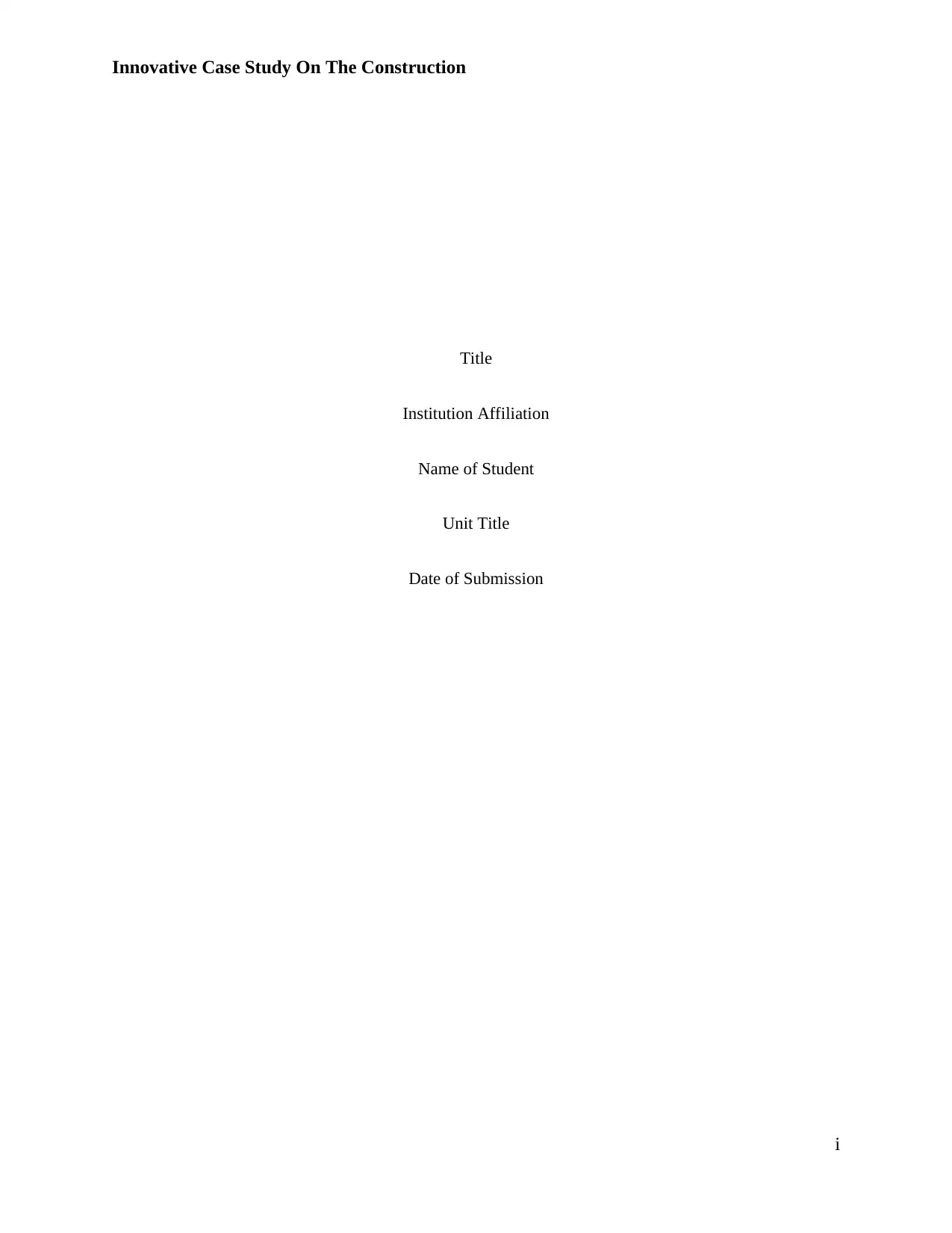
Innovative Case Study On The Construction
Title
Institution Affiliation
Name of Student
Unit Title
Date of Submission
i
Title
Institution Affiliation
Name of Student
Unit Title
Date of Submission
i
Paraphrase This Document
Need a fresh take? Get an instant paraphrase of this document with our AI Paraphraser
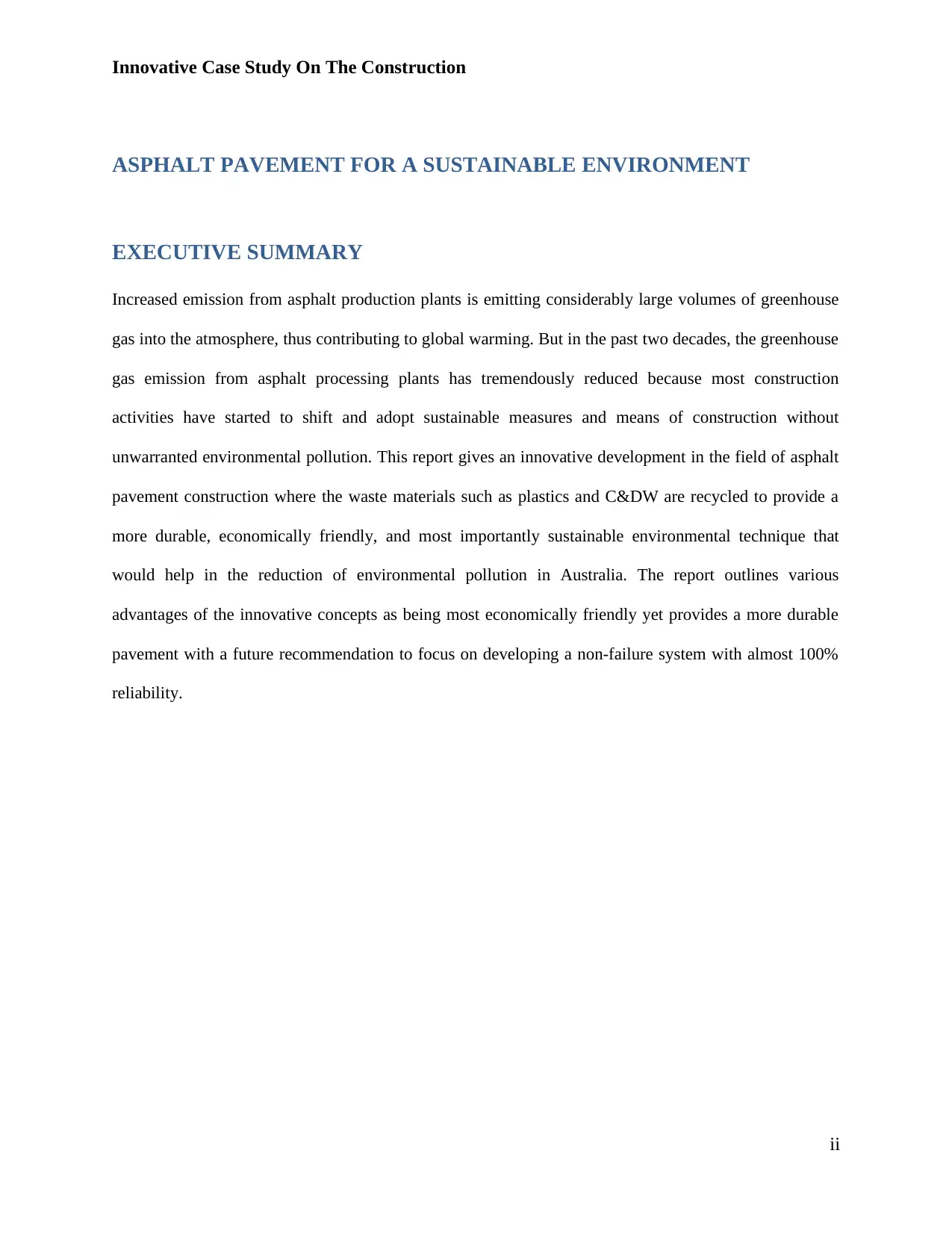
Innovative Case Study On The Construction
ASPHALT PAVEMENT FOR A SUSTAINABLE ENVIRONMENT
EXECUTIVE SUMMARY
Increased emission from asphalt production plants is emitting considerably large volumes of greenhouse
gas into the atmosphere, thus contributing to global warming. But in the past two decades, the greenhouse
gas emission from asphalt processing plants has tremendously reduced because most construction
activities have started to shift and adopt sustainable measures and means of construction without
unwarranted environmental pollution. This report gives an innovative development in the field of asphalt
pavement construction where the waste materials such as plastics and C&DW are recycled to provide a
more durable, economically friendly, and most importantly sustainable environmental technique that
would help in the reduction of environmental pollution in Australia. The report outlines various
advantages of the innovative concepts as being most economically friendly yet provides a more durable
pavement with a future recommendation to focus on developing a non-failure system with almost 100%
reliability.
ii
ASPHALT PAVEMENT FOR A SUSTAINABLE ENVIRONMENT
EXECUTIVE SUMMARY
Increased emission from asphalt production plants is emitting considerably large volumes of greenhouse
gas into the atmosphere, thus contributing to global warming. But in the past two decades, the greenhouse
gas emission from asphalt processing plants has tremendously reduced because most construction
activities have started to shift and adopt sustainable measures and means of construction without
unwarranted environmental pollution. This report gives an innovative development in the field of asphalt
pavement construction where the waste materials such as plastics and C&DW are recycled to provide a
more durable, economically friendly, and most importantly sustainable environmental technique that
would help in the reduction of environmental pollution in Australia. The report outlines various
advantages of the innovative concepts as being most economically friendly yet provides a more durable
pavement with a future recommendation to focus on developing a non-failure system with almost 100%
reliability.
ii
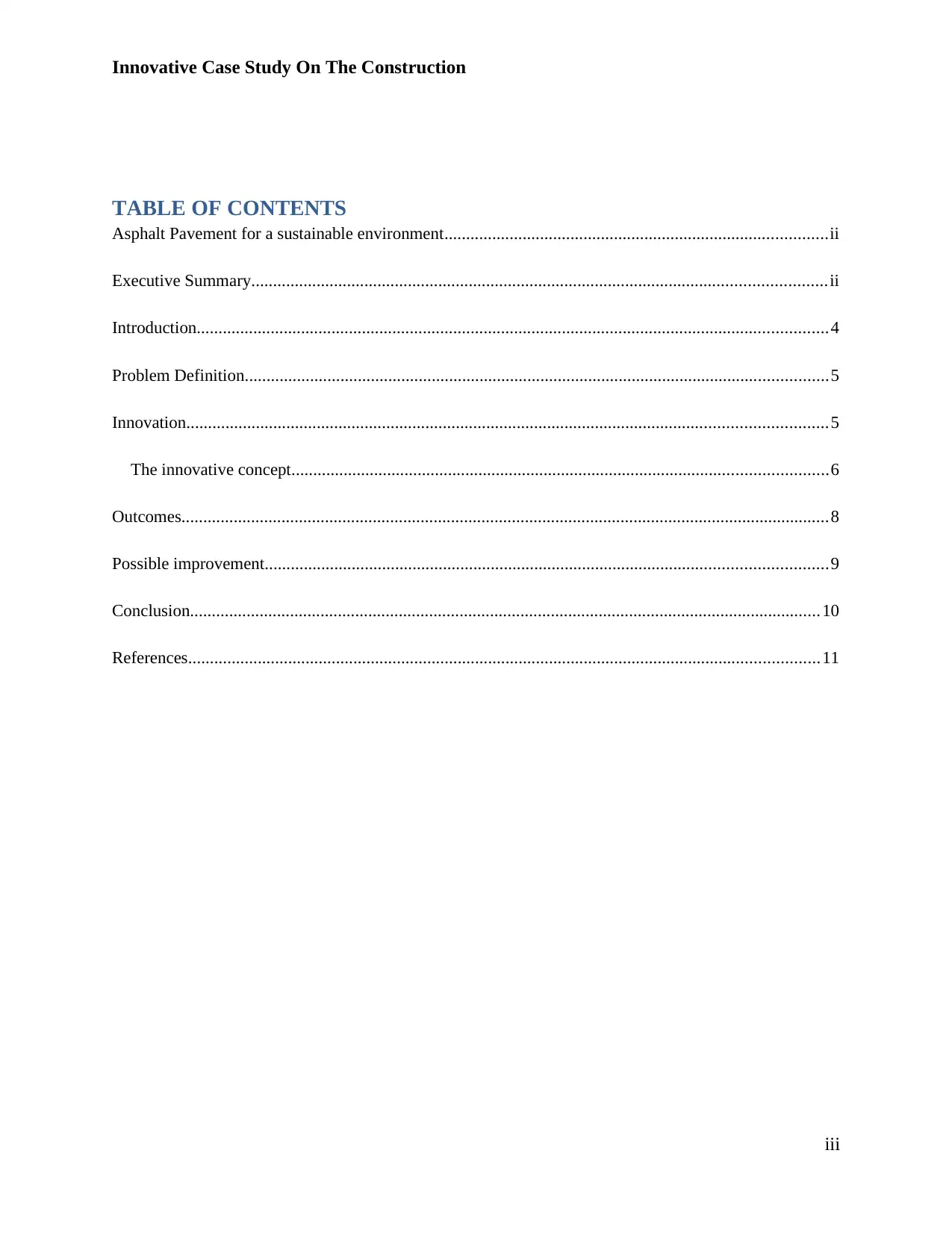
Innovative Case Study On The Construction
TABLE OF CONTENTS
Asphalt Pavement for a sustainable environment........................................................................................ii
Executive Summary....................................................................................................................................ii
Introduction.................................................................................................................................................4
Problem Definition......................................................................................................................................5
Innovation...................................................................................................................................................5
The innovative concept...........................................................................................................................6
Outcomes.....................................................................................................................................................8
Possible improvement.................................................................................................................................9
Conclusion.................................................................................................................................................10
References.................................................................................................................................................11
iii
TABLE OF CONTENTS
Asphalt Pavement for a sustainable environment........................................................................................ii
Executive Summary....................................................................................................................................ii
Introduction.................................................................................................................................................4
Problem Definition......................................................................................................................................5
Innovation...................................................................................................................................................5
The innovative concept...........................................................................................................................6
Outcomes.....................................................................................................................................................8
Possible improvement.................................................................................................................................9
Conclusion.................................................................................................................................................10
References.................................................................................................................................................11
iii
⊘ This is a preview!⊘
Do you want full access?
Subscribe today to unlock all pages.

Trusted by 1+ million students worldwide
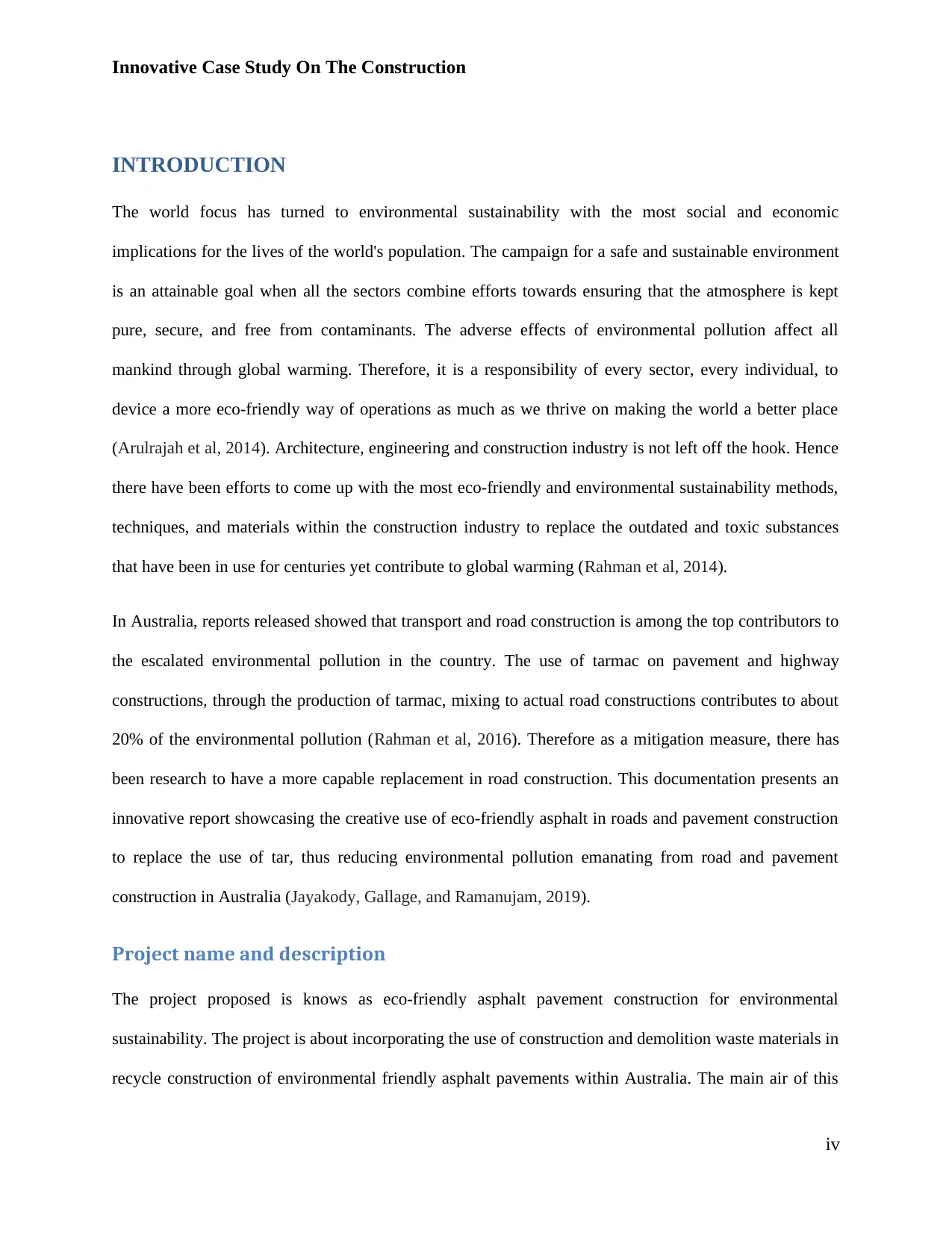
Innovative Case Study On The Construction
INTRODUCTION
The world focus has turned to environmental sustainability with the most social and economic
implications for the lives of the world's population. The campaign for a safe and sustainable environment
is an attainable goal when all the sectors combine efforts towards ensuring that the atmosphere is kept
pure, secure, and free from contaminants. The adverse effects of environmental pollution affect all
mankind through global warming. Therefore, it is a responsibility of every sector, every individual, to
device a more eco-friendly way of operations as much as we thrive on making the world a better place
(Arulrajah et al, 2014). Architecture, engineering and construction industry is not left off the hook. Hence
there have been efforts to come up with the most eco-friendly and environmental sustainability methods,
techniques, and materials within the construction industry to replace the outdated and toxic substances
that have been in use for centuries yet contribute to global warming (Rahman et al, 2014).
In Australia, reports released showed that transport and road construction is among the top contributors to
the escalated environmental pollution in the country. The use of tarmac on pavement and highway
constructions, through the production of tarmac, mixing to actual road constructions contributes to about
20% of the environmental pollution (Rahman et al, 2016). Therefore as a mitigation measure, there has
been research to have a more capable replacement in road construction. This documentation presents an
innovative report showcasing the creative use of eco-friendly asphalt in roads and pavement construction
to replace the use of tar, thus reducing environmental pollution emanating from road and pavement
construction in Australia (Jayakody, Gallage, and Ramanujam, 2019).
Project name and description
The project proposed is knows as eco-friendly asphalt pavement construction for environmental
sustainability. The project is about incorporating the use of construction and demolition waste materials in
recycle construction of environmental friendly asphalt pavements within Australia. The main air of this
iv
INTRODUCTION
The world focus has turned to environmental sustainability with the most social and economic
implications for the lives of the world's population. The campaign for a safe and sustainable environment
is an attainable goal when all the sectors combine efforts towards ensuring that the atmosphere is kept
pure, secure, and free from contaminants. The adverse effects of environmental pollution affect all
mankind through global warming. Therefore, it is a responsibility of every sector, every individual, to
device a more eco-friendly way of operations as much as we thrive on making the world a better place
(Arulrajah et al, 2014). Architecture, engineering and construction industry is not left off the hook. Hence
there have been efforts to come up with the most eco-friendly and environmental sustainability methods,
techniques, and materials within the construction industry to replace the outdated and toxic substances
that have been in use for centuries yet contribute to global warming (Rahman et al, 2014).
In Australia, reports released showed that transport and road construction is among the top contributors to
the escalated environmental pollution in the country. The use of tarmac on pavement and highway
constructions, through the production of tarmac, mixing to actual road constructions contributes to about
20% of the environmental pollution (Rahman et al, 2016). Therefore as a mitigation measure, there has
been research to have a more capable replacement in road construction. This documentation presents an
innovative report showcasing the creative use of eco-friendly asphalt in roads and pavement construction
to replace the use of tar, thus reducing environmental pollution emanating from road and pavement
construction in Australia (Jayakody, Gallage, and Ramanujam, 2019).
Project name and description
The project proposed is knows as eco-friendly asphalt pavement construction for environmental
sustainability. The project is about incorporating the use of construction and demolition waste materials in
recycle construction of environmental friendly asphalt pavements within Australia. The main air of this
iv
Paraphrase This Document
Need a fresh take? Get an instant paraphrase of this document with our AI Paraphraser
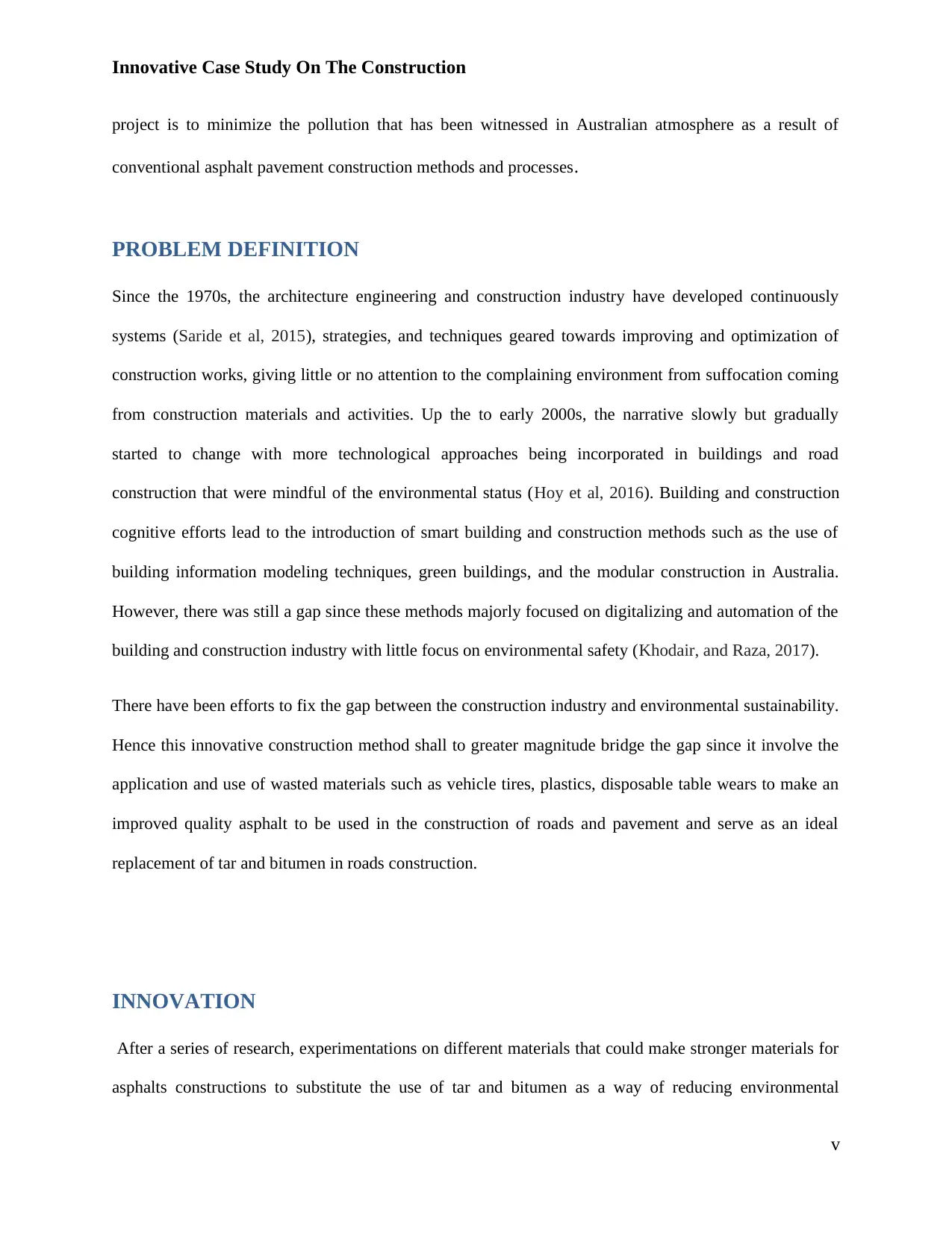
Innovative Case Study On The Construction
project is to minimize the pollution that has been witnessed in Australian atmosphere as a result of
conventional asphalt pavement construction methods and processes.
PROBLEM DEFINITION
Since the 1970s, the architecture engineering and construction industry have developed continuously
systems (Saride et al, 2015), strategies, and techniques geared towards improving and optimization of
construction works, giving little or no attention to the complaining environment from suffocation coming
from construction materials and activities. Up the to early 2000s, the narrative slowly but gradually
started to change with more technological approaches being incorporated in buildings and road
construction that were mindful of the environmental status (Hoy et al, 2016). Building and construction
cognitive efforts lead to the introduction of smart building and construction methods such as the use of
building information modeling techniques, green buildings, and the modular construction in Australia.
However, there was still a gap since these methods majorly focused on digitalizing and automation of the
building and construction industry with little focus on environmental safety (Khodair, and Raza, 2017).
There have been efforts to fix the gap between the construction industry and environmental sustainability.
Hence this innovative construction method shall to greater magnitude bridge the gap since it involve the
application and use of wasted materials such as vehicle tires, plastics, disposable table wears to make an
improved quality asphalt to be used in the construction of roads and pavement and serve as an ideal
replacement of tar and bitumen in roads construction.
INNOVATION
After a series of research, experimentations on different materials that could make stronger materials for
asphalts constructions to substitute the use of tar and bitumen as a way of reducing environmental
v
project is to minimize the pollution that has been witnessed in Australian atmosphere as a result of
conventional asphalt pavement construction methods and processes.
PROBLEM DEFINITION
Since the 1970s, the architecture engineering and construction industry have developed continuously
systems (Saride et al, 2015), strategies, and techniques geared towards improving and optimization of
construction works, giving little or no attention to the complaining environment from suffocation coming
from construction materials and activities. Up the to early 2000s, the narrative slowly but gradually
started to change with more technological approaches being incorporated in buildings and road
construction that were mindful of the environmental status (Hoy et al, 2016). Building and construction
cognitive efforts lead to the introduction of smart building and construction methods such as the use of
building information modeling techniques, green buildings, and the modular construction in Australia.
However, there was still a gap since these methods majorly focused on digitalizing and automation of the
building and construction industry with little focus on environmental safety (Khodair, and Raza, 2017).
There have been efforts to fix the gap between the construction industry and environmental sustainability.
Hence this innovative construction method shall to greater magnitude bridge the gap since it involve the
application and use of wasted materials such as vehicle tires, plastics, disposable table wears to make an
improved quality asphalt to be used in the construction of roads and pavement and serve as an ideal
replacement of tar and bitumen in roads construction.
INNOVATION
After a series of research, experimentations on different materials that could make stronger materials for
asphalts constructions to substitute the use of tar and bitumen as a way of reducing environmental
v
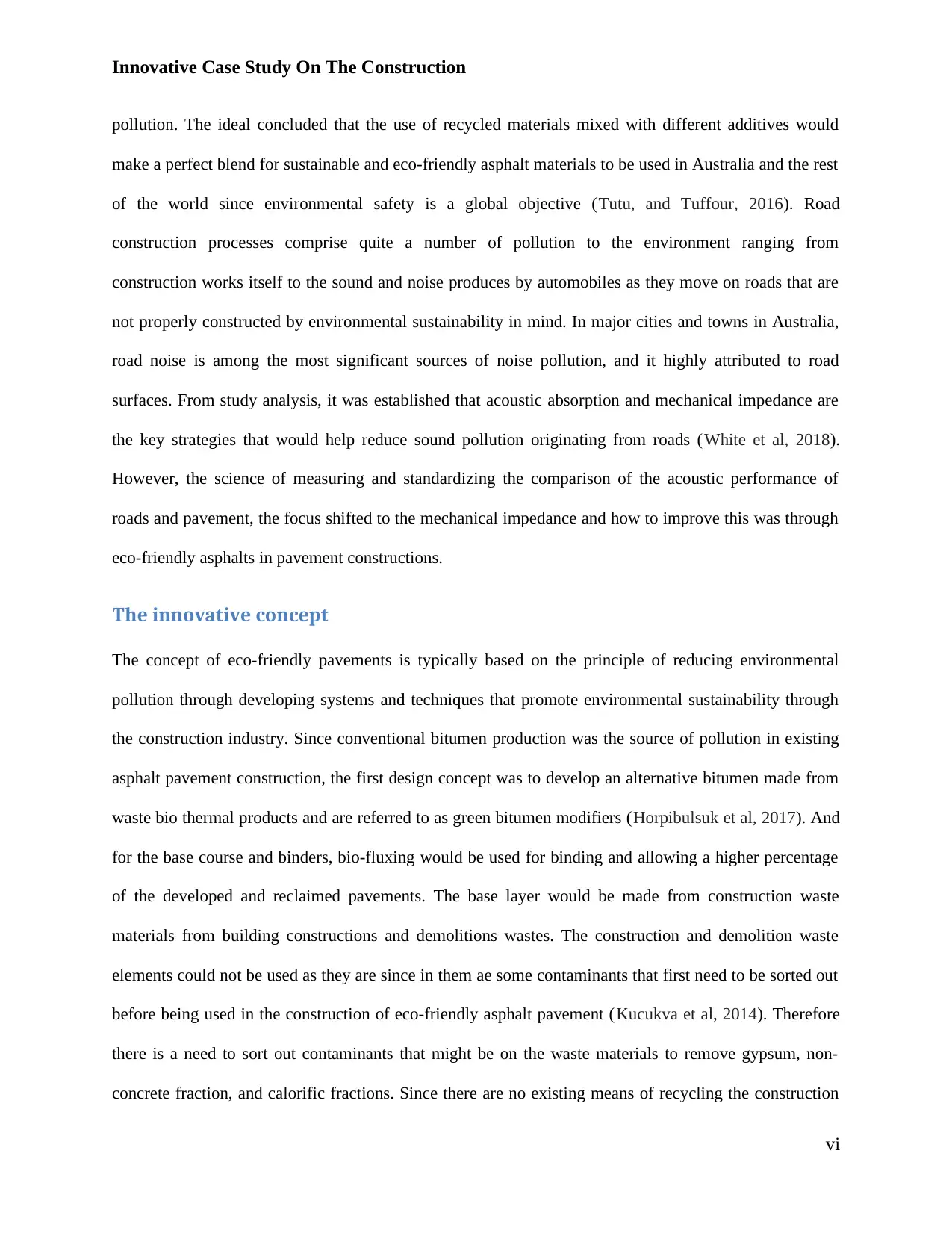
Innovative Case Study On The Construction
pollution. The ideal concluded that the use of recycled materials mixed with different additives would
make a perfect blend for sustainable and eco-friendly asphalt materials to be used in Australia and the rest
of the world since environmental safety is a global objective (Tutu, and Tuffour, 2016). Road
construction processes comprise quite a number of pollution to the environment ranging from
construction works itself to the sound and noise produces by automobiles as they move on roads that are
not properly constructed by environmental sustainability in mind. In major cities and towns in Australia,
road noise is among the most significant sources of noise pollution, and it highly attributed to road
surfaces. From study analysis, it was established that acoustic absorption and mechanical impedance are
the key strategies that would help reduce sound pollution originating from roads (White et al, 2018).
However, the science of measuring and standardizing the comparison of the acoustic performance of
roads and pavement, the focus shifted to the mechanical impedance and how to improve this was through
eco-friendly asphalts in pavement constructions.
The innovative concept
The concept of eco-friendly pavements is typically based on the principle of reducing environmental
pollution through developing systems and techniques that promote environmental sustainability through
the construction industry. Since conventional bitumen production was the source of pollution in existing
asphalt pavement construction, the first design concept was to develop an alternative bitumen made from
waste bio thermal products and are referred to as green bitumen modifiers (Horpibulsuk et al, 2017). And
for the base course and binders, bio-fluxing would be used for binding and allowing a higher percentage
of the developed and reclaimed pavements. The base layer would be made from construction waste
materials from building constructions and demolitions wastes. The construction and demolition waste
elements could not be used as they are since in them ae some contaminants that first need to be sorted out
before being used in the construction of eco-friendly asphalt pavement (Kucukva et al, 2014). Therefore
there is a need to sort out contaminants that might be on the waste materials to remove gypsum, non-
concrete fraction, and calorific fractions. Since there are no existing means of recycling the construction
vi
pollution. The ideal concluded that the use of recycled materials mixed with different additives would
make a perfect blend for sustainable and eco-friendly asphalt materials to be used in Australia and the rest
of the world since environmental safety is a global objective (Tutu, and Tuffour, 2016). Road
construction processes comprise quite a number of pollution to the environment ranging from
construction works itself to the sound and noise produces by automobiles as they move on roads that are
not properly constructed by environmental sustainability in mind. In major cities and towns in Australia,
road noise is among the most significant sources of noise pollution, and it highly attributed to road
surfaces. From study analysis, it was established that acoustic absorption and mechanical impedance are
the key strategies that would help reduce sound pollution originating from roads (White et al, 2018).
However, the science of measuring and standardizing the comparison of the acoustic performance of
roads and pavement, the focus shifted to the mechanical impedance and how to improve this was through
eco-friendly asphalts in pavement constructions.
The innovative concept
The concept of eco-friendly pavements is typically based on the principle of reducing environmental
pollution through developing systems and techniques that promote environmental sustainability through
the construction industry. Since conventional bitumen production was the source of pollution in existing
asphalt pavement construction, the first design concept was to develop an alternative bitumen made from
waste bio thermal products and are referred to as green bitumen modifiers (Horpibulsuk et al, 2017). And
for the base course and binders, bio-fluxing would be used for binding and allowing a higher percentage
of the developed and reclaimed pavements. The base layer would be made from construction waste
materials from building constructions and demolitions wastes. The construction and demolition waste
elements could not be used as they are since in them ae some contaminants that first need to be sorted out
before being used in the construction of eco-friendly asphalt pavement (Kucukva et al, 2014). Therefore
there is a need to sort out contaminants that might be on the waste materials to remove gypsum, non-
concrete fraction, and calorific fractions. Since there are no existing means of recycling the construction
vi
⊘ This is a preview!⊘
Do you want full access?
Subscribe today to unlock all pages.

Trusted by 1+ million students worldwide
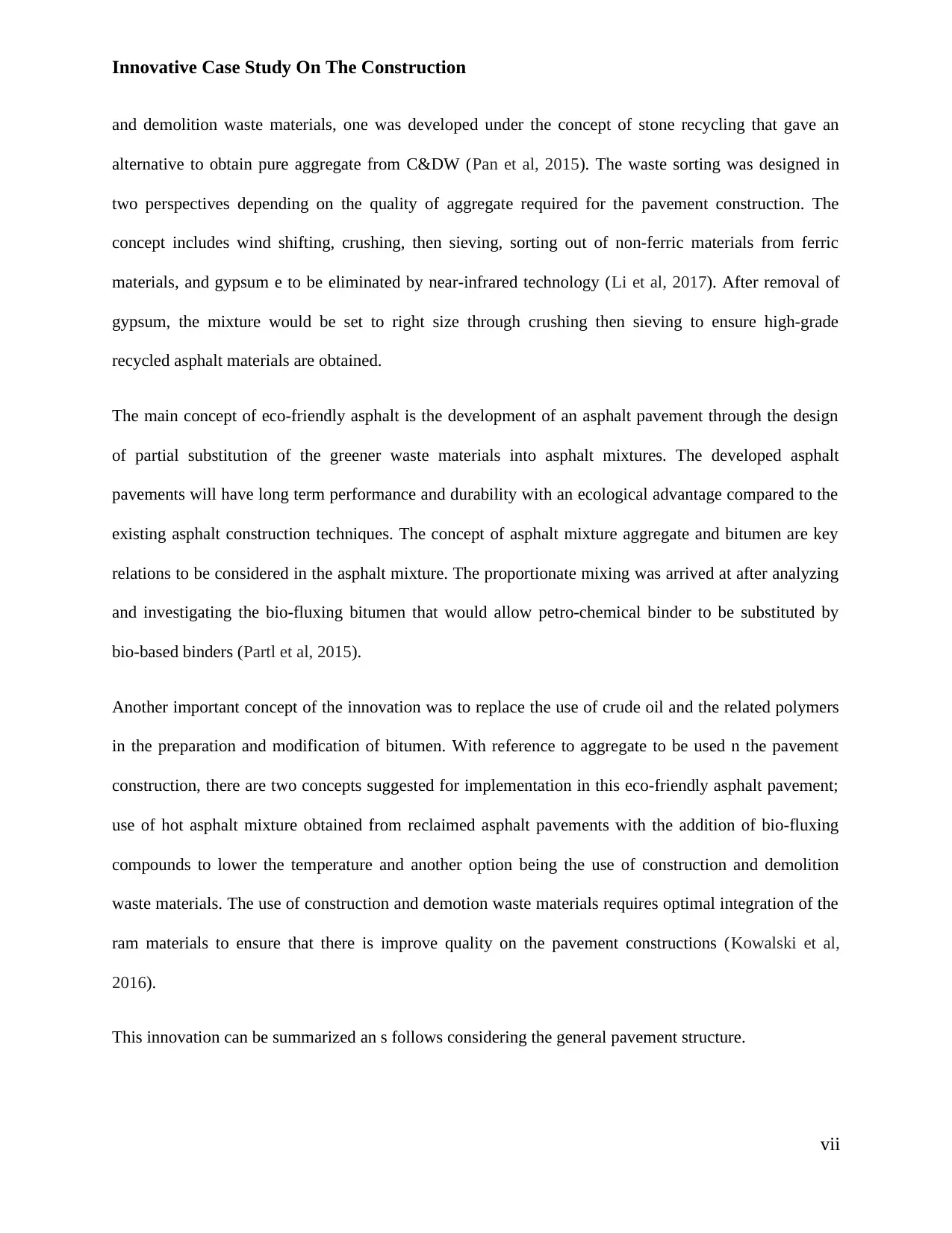
Innovative Case Study On The Construction
and demolition waste materials, one was developed under the concept of stone recycling that gave an
alternative to obtain pure aggregate from C&DW (Pan et al, 2015). The waste sorting was designed in
two perspectives depending on the quality of aggregate required for the pavement construction. The
concept includes wind shifting, crushing, then sieving, sorting out of non-ferric materials from ferric
materials, and gypsum e to be eliminated by near-infrared technology (Li et al, 2017). After removal of
gypsum, the mixture would be set to right size through crushing then sieving to ensure high-grade
recycled asphalt materials are obtained.
The main concept of eco-friendly asphalt is the development of an asphalt pavement through the design
of partial substitution of the greener waste materials into asphalt mixtures. The developed asphalt
pavements will have long term performance and durability with an ecological advantage compared to the
existing asphalt construction techniques. The concept of asphalt mixture aggregate and bitumen are key
relations to be considered in the asphalt mixture. The proportionate mixing was arrived at after analyzing
and investigating the bio-fluxing bitumen that would allow petro-chemical binder to be substituted by
bio-based binders (Partl et al, 2015).
Another important concept of the innovation was to replace the use of crude oil and the related polymers
in the preparation and modification of bitumen. With reference to aggregate to be used n the pavement
construction, there are two concepts suggested for implementation in this eco-friendly asphalt pavement;
use of hot asphalt mixture obtained from reclaimed asphalt pavements with the addition of bio-fluxing
compounds to lower the temperature and another option being the use of construction and demolition
waste materials. The use of construction and demotion waste materials requires optimal integration of the
ram materials to ensure that there is improve quality on the pavement constructions (Kowalski et al,
2016).
This innovation can be summarized an s follows considering the general pavement structure.
vii
and demolition waste materials, one was developed under the concept of stone recycling that gave an
alternative to obtain pure aggregate from C&DW (Pan et al, 2015). The waste sorting was designed in
two perspectives depending on the quality of aggregate required for the pavement construction. The
concept includes wind shifting, crushing, then sieving, sorting out of non-ferric materials from ferric
materials, and gypsum e to be eliminated by near-infrared technology (Li et al, 2017). After removal of
gypsum, the mixture would be set to right size through crushing then sieving to ensure high-grade
recycled asphalt materials are obtained.
The main concept of eco-friendly asphalt is the development of an asphalt pavement through the design
of partial substitution of the greener waste materials into asphalt mixtures. The developed asphalt
pavements will have long term performance and durability with an ecological advantage compared to the
existing asphalt construction techniques. The concept of asphalt mixture aggregate and bitumen are key
relations to be considered in the asphalt mixture. The proportionate mixing was arrived at after analyzing
and investigating the bio-fluxing bitumen that would allow petro-chemical binder to be substituted by
bio-based binders (Partl et al, 2015).
Another important concept of the innovation was to replace the use of crude oil and the related polymers
in the preparation and modification of bitumen. With reference to aggregate to be used n the pavement
construction, there are two concepts suggested for implementation in this eco-friendly asphalt pavement;
use of hot asphalt mixture obtained from reclaimed asphalt pavements with the addition of bio-fluxing
compounds to lower the temperature and another option being the use of construction and demolition
waste materials. The use of construction and demotion waste materials requires optimal integration of the
ram materials to ensure that there is improve quality on the pavement constructions (Kowalski et al,
2016).
This innovation can be summarized an s follows considering the general pavement structure.
vii
Paraphrase This Document
Need a fresh take? Get an instant paraphrase of this document with our AI Paraphraser
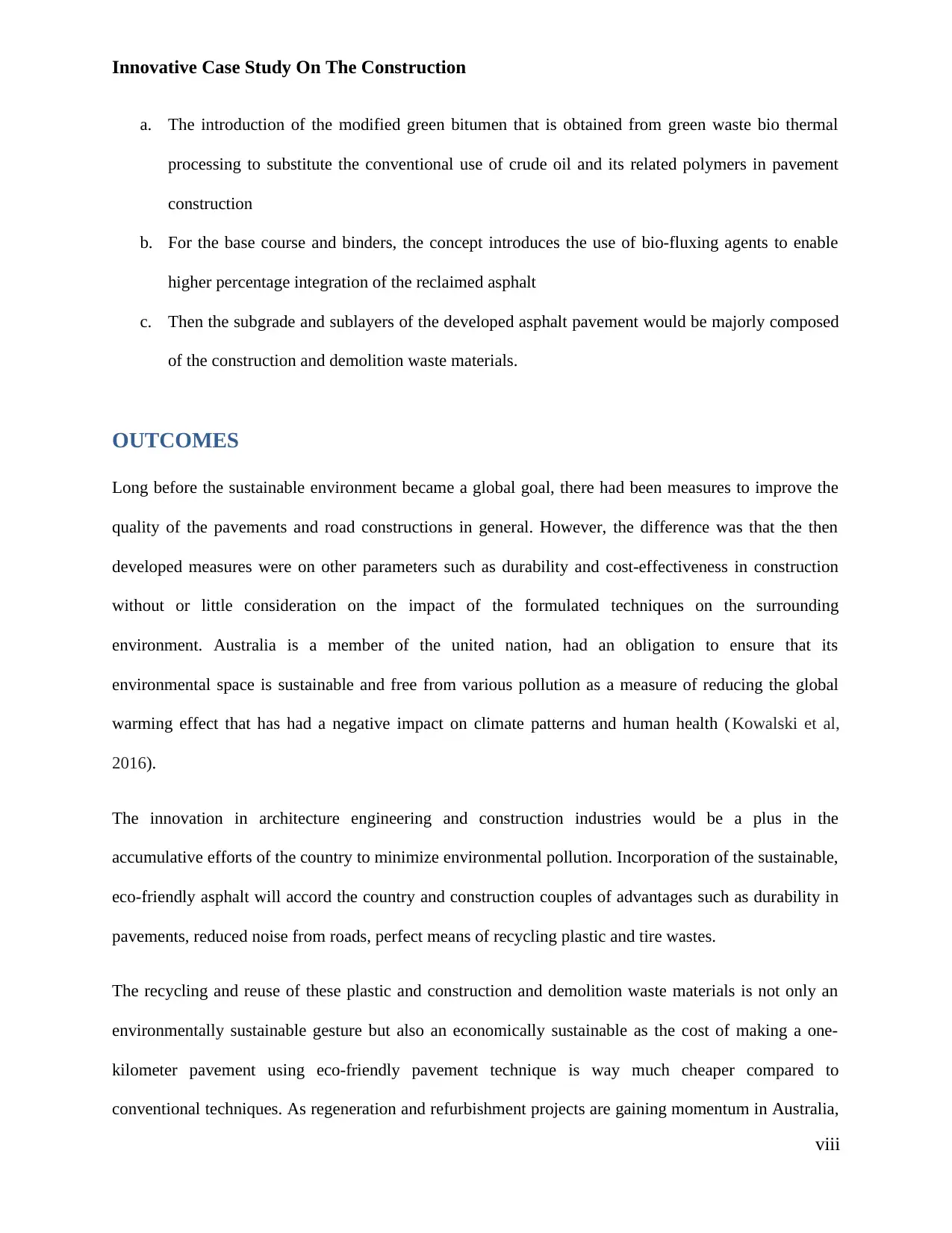
Innovative Case Study On The Construction
a. The introduction of the modified green bitumen that is obtained from green waste bio thermal
processing to substitute the conventional use of crude oil and its related polymers in pavement
construction
b. For the base course and binders, the concept introduces the use of bio-fluxing agents to enable
higher percentage integration of the reclaimed asphalt
c. Then the subgrade and sublayers of the developed asphalt pavement would be majorly composed
of the construction and demolition waste materials.
OUTCOMES
Long before the sustainable environment became a global goal, there had been measures to improve the
quality of the pavements and road constructions in general. However, the difference was that the then
developed measures were on other parameters such as durability and cost-effectiveness in construction
without or little consideration on the impact of the formulated techniques on the surrounding
environment. Australia is a member of the united nation, had an obligation to ensure that its
environmental space is sustainable and free from various pollution as a measure of reducing the global
warming effect that has had a negative impact on climate patterns and human health ( Kowalski et al,
2016).
The innovation in architecture engineering and construction industries would be a plus in the
accumulative efforts of the country to minimize environmental pollution. Incorporation of the sustainable,
eco-friendly asphalt will accord the country and construction couples of advantages such as durability in
pavements, reduced noise from roads, perfect means of recycling plastic and tire wastes.
The recycling and reuse of these plastic and construction and demolition waste materials is not only an
environmentally sustainable gesture but also an economically sustainable as the cost of making a one-
kilometer pavement using eco-friendly pavement technique is way much cheaper compared to
conventional techniques. As regeneration and refurbishment projects are gaining momentum in Australia,
viii
a. The introduction of the modified green bitumen that is obtained from green waste bio thermal
processing to substitute the conventional use of crude oil and its related polymers in pavement
construction
b. For the base course and binders, the concept introduces the use of bio-fluxing agents to enable
higher percentage integration of the reclaimed asphalt
c. Then the subgrade and sublayers of the developed asphalt pavement would be majorly composed
of the construction and demolition waste materials.
OUTCOMES
Long before the sustainable environment became a global goal, there had been measures to improve the
quality of the pavements and road constructions in general. However, the difference was that the then
developed measures were on other parameters such as durability and cost-effectiveness in construction
without or little consideration on the impact of the formulated techniques on the surrounding
environment. Australia is a member of the united nation, had an obligation to ensure that its
environmental space is sustainable and free from various pollution as a measure of reducing the global
warming effect that has had a negative impact on climate patterns and human health ( Kowalski et al,
2016).
The innovation in architecture engineering and construction industries would be a plus in the
accumulative efforts of the country to minimize environmental pollution. Incorporation of the sustainable,
eco-friendly asphalt will accord the country and construction couples of advantages such as durability in
pavements, reduced noise from roads, perfect means of recycling plastic and tire wastes.
The recycling and reuse of these plastic and construction and demolition waste materials is not only an
environmentally sustainable gesture but also an economically sustainable as the cost of making a one-
kilometer pavement using eco-friendly pavement technique is way much cheaper compared to
conventional techniques. As regeneration and refurbishment projects are gaining momentum in Australia,
viii
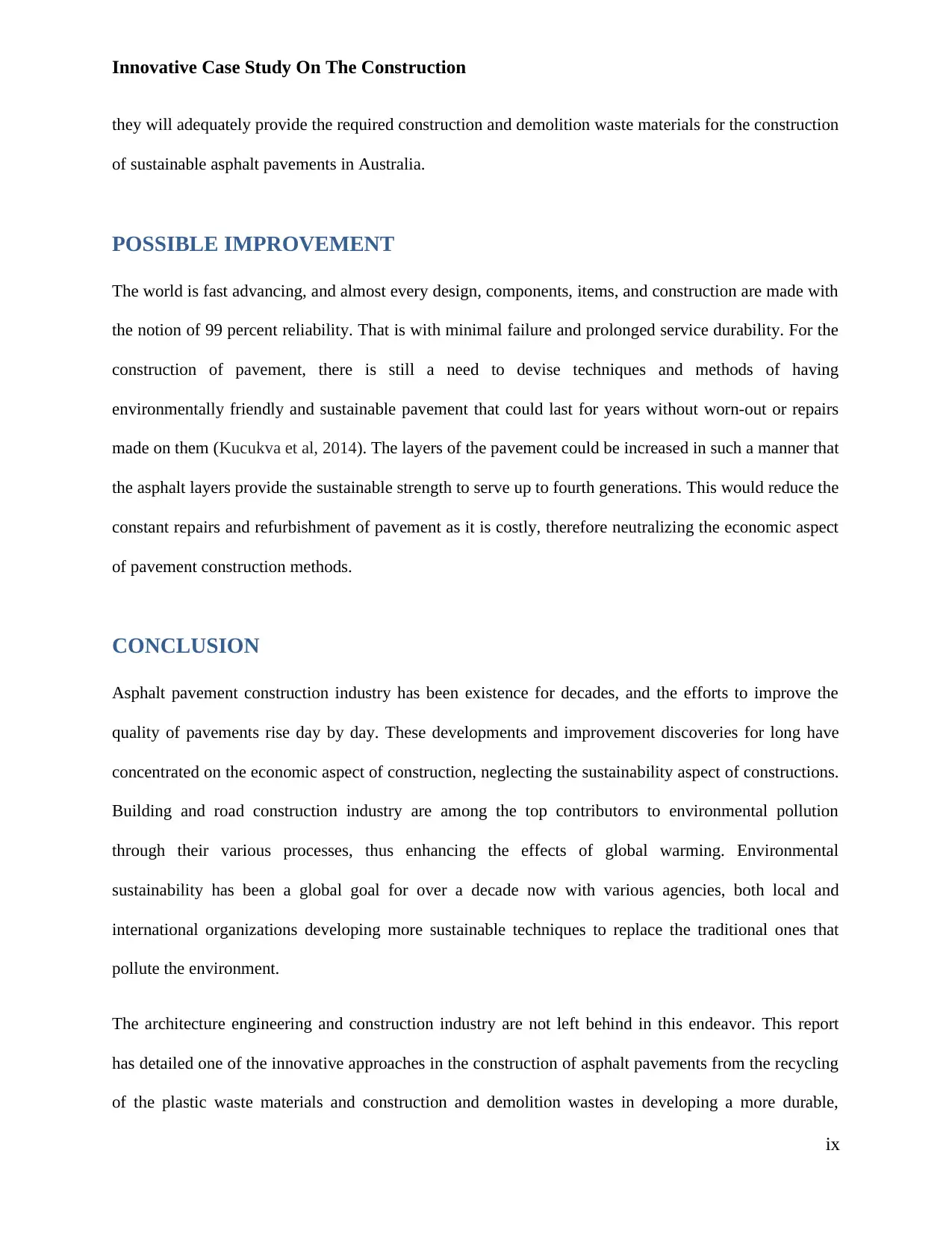
Innovative Case Study On The Construction
they will adequately provide the required construction and demolition waste materials for the construction
of sustainable asphalt pavements in Australia.
POSSIBLE IMPROVEMENT
The world is fast advancing, and almost every design, components, items, and construction are made with
the notion of 99 percent reliability. That is with minimal failure and prolonged service durability. For the
construction of pavement, there is still a need to devise techniques and methods of having
environmentally friendly and sustainable pavement that could last for years without worn-out or repairs
made on them (Kucukva et al, 2014). The layers of the pavement could be increased in such a manner that
the asphalt layers provide the sustainable strength to serve up to fourth generations. This would reduce the
constant repairs and refurbishment of pavement as it is costly, therefore neutralizing the economic aspect
of pavement construction methods.
CONCLUSION
Asphalt pavement construction industry has been existence for decades, and the efforts to improve the
quality of pavements rise day by day. These developments and improvement discoveries for long have
concentrated on the economic aspect of construction, neglecting the sustainability aspect of constructions.
Building and road construction industry are among the top contributors to environmental pollution
through their various processes, thus enhancing the effects of global warming. Environmental
sustainability has been a global goal for over a decade now with various agencies, both local and
international organizations developing more sustainable techniques to replace the traditional ones that
pollute the environment.
The architecture engineering and construction industry are not left behind in this endeavor. This report
has detailed one of the innovative approaches in the construction of asphalt pavements from the recycling
of the plastic waste materials and construction and demolition wastes in developing a more durable,
ix
they will adequately provide the required construction and demolition waste materials for the construction
of sustainable asphalt pavements in Australia.
POSSIBLE IMPROVEMENT
The world is fast advancing, and almost every design, components, items, and construction are made with
the notion of 99 percent reliability. That is with minimal failure and prolonged service durability. For the
construction of pavement, there is still a need to devise techniques and methods of having
environmentally friendly and sustainable pavement that could last for years without worn-out or repairs
made on them (Kucukva et al, 2014). The layers of the pavement could be increased in such a manner that
the asphalt layers provide the sustainable strength to serve up to fourth generations. This would reduce the
constant repairs and refurbishment of pavement as it is costly, therefore neutralizing the economic aspect
of pavement construction methods.
CONCLUSION
Asphalt pavement construction industry has been existence for decades, and the efforts to improve the
quality of pavements rise day by day. These developments and improvement discoveries for long have
concentrated on the economic aspect of construction, neglecting the sustainability aspect of constructions.
Building and road construction industry are among the top contributors to environmental pollution
through their various processes, thus enhancing the effects of global warming. Environmental
sustainability has been a global goal for over a decade now with various agencies, both local and
international organizations developing more sustainable techniques to replace the traditional ones that
pollute the environment.
The architecture engineering and construction industry are not left behind in this endeavor. This report
has detailed one of the innovative approaches in the construction of asphalt pavements from the recycling
of the plastic waste materials and construction and demolition wastes in developing a more durable,
ix
⊘ This is a preview!⊘
Do you want full access?
Subscribe today to unlock all pages.

Trusted by 1+ million students worldwide

Innovative Case Study On The Construction
economically friendly, and environmentally sustainable pavement. The innovation presents numerous
advantages over existing techniques such as reduced noise pollution that often emanate from our roads,
reliability, and sustainability, therefore, impacting positively in the construction industry and providing a
measure of mitigating a global disaster, global warming.
x
economically friendly, and environmentally sustainable pavement. The innovation presents numerous
advantages over existing techniques such as reduced noise pollution that often emanate from our roads,
reliability, and sustainability, therefore, impacting positively in the construction industry and providing a
measure of mitigating a global disaster, global warming.
x
Paraphrase This Document
Need a fresh take? Get an instant paraphrase of this document with our AI Paraphraser
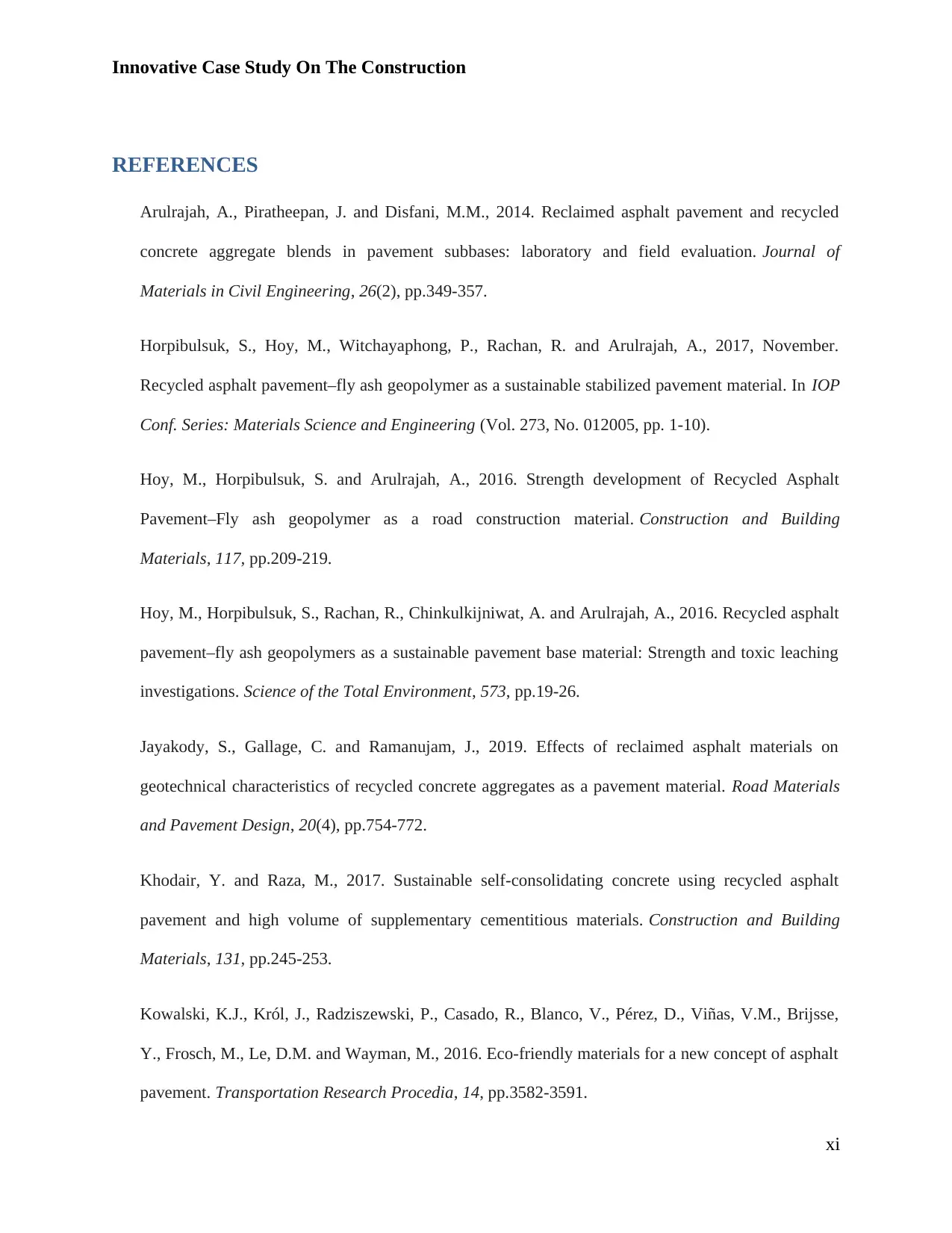
Innovative Case Study On The Construction
REFERENCES
Arulrajah, A., Piratheepan, J. and Disfani, M.M., 2014. Reclaimed asphalt pavement and recycled
concrete aggregate blends in pavement subbases: laboratory and field evaluation. Journal of
Materials in Civil Engineering, 26(2), pp.349-357.
Horpibulsuk, S., Hoy, M., Witchayaphong, P., Rachan, R. and Arulrajah, A., 2017, November.
Recycled asphalt pavement–fly ash geopolymer as a sustainable stabilized pavement material. In IOP
Conf. Series: Materials Science and Engineering (Vol. 273, No. 012005, pp. 1-10).
Hoy, M., Horpibulsuk, S. and Arulrajah, A., 2016. Strength development of Recycled Asphalt
Pavement–Fly ash geopolymer as a road construction material. Construction and Building
Materials, 117, pp.209-219.
Hoy, M., Horpibulsuk, S., Rachan, R., Chinkulkijniwat, A. and Arulrajah, A., 2016. Recycled asphalt
pavement–fly ash geopolymers as a sustainable pavement base material: Strength and toxic leaching
investigations. Science of the Total Environment, 573, pp.19-26.
Jayakody, S., Gallage, C. and Ramanujam, J., 2019. Effects of reclaimed asphalt materials on
geotechnical characteristics of recycled concrete aggregates as a pavement material. Road Materials
and Pavement Design, 20(4), pp.754-772.
Khodair, Y. and Raza, M., 2017. Sustainable self-consolidating concrete using recycled asphalt
pavement and high volume of supplementary cementitious materials. Construction and Building
Materials, 131, pp.245-253.
Kowalski, K.J., Król, J., Radziszewski, P., Casado, R., Blanco, V., Pérez, D., Viñas, V.M., Brijsse,
Y., Frosch, M., Le, D.M. and Wayman, M., 2016. Eco-friendly materials for a new concept of asphalt
pavement. Transportation Research Procedia, 14, pp.3582-3591.
xi
REFERENCES
Arulrajah, A., Piratheepan, J. and Disfani, M.M., 2014. Reclaimed asphalt pavement and recycled
concrete aggregate blends in pavement subbases: laboratory and field evaluation. Journal of
Materials in Civil Engineering, 26(2), pp.349-357.
Horpibulsuk, S., Hoy, M., Witchayaphong, P., Rachan, R. and Arulrajah, A., 2017, November.
Recycled asphalt pavement–fly ash geopolymer as a sustainable stabilized pavement material. In IOP
Conf. Series: Materials Science and Engineering (Vol. 273, No. 012005, pp. 1-10).
Hoy, M., Horpibulsuk, S. and Arulrajah, A., 2016. Strength development of Recycled Asphalt
Pavement–Fly ash geopolymer as a road construction material. Construction and Building
Materials, 117, pp.209-219.
Hoy, M., Horpibulsuk, S., Rachan, R., Chinkulkijniwat, A. and Arulrajah, A., 2016. Recycled asphalt
pavement–fly ash geopolymers as a sustainable pavement base material: Strength and toxic leaching
investigations. Science of the Total Environment, 573, pp.19-26.
Jayakody, S., Gallage, C. and Ramanujam, J., 2019. Effects of reclaimed asphalt materials on
geotechnical characteristics of recycled concrete aggregates as a pavement material. Road Materials
and Pavement Design, 20(4), pp.754-772.
Khodair, Y. and Raza, M., 2017. Sustainable self-consolidating concrete using recycled asphalt
pavement and high volume of supplementary cementitious materials. Construction and Building
Materials, 131, pp.245-253.
Kowalski, K.J., Król, J., Radziszewski, P., Casado, R., Blanco, V., Pérez, D., Viñas, V.M., Brijsse,
Y., Frosch, M., Le, D.M. and Wayman, M., 2016. Eco-friendly materials for a new concept of asphalt
pavement. Transportation Research Procedia, 14, pp.3582-3591.
xi
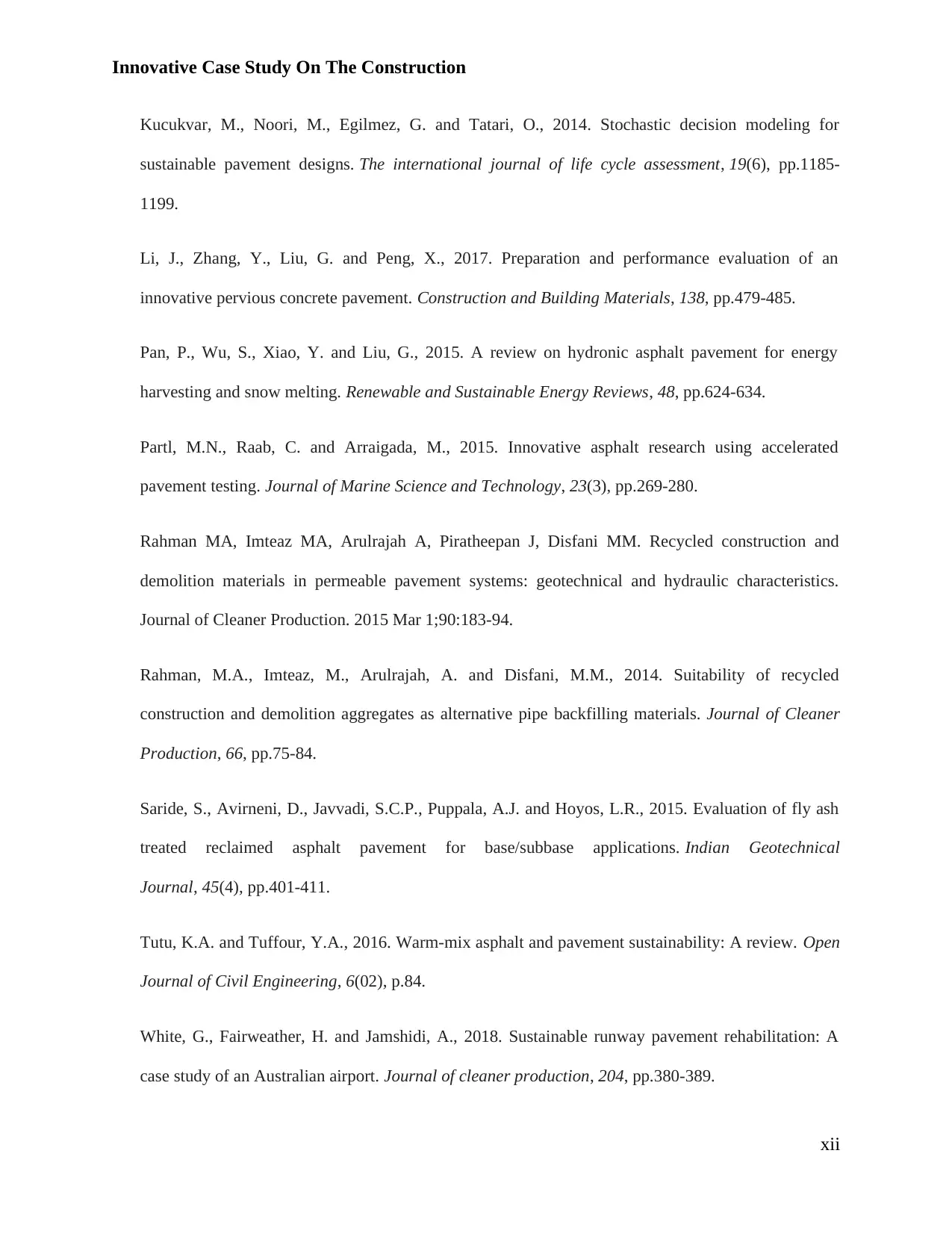
Innovative Case Study On The Construction
Kucukvar, M., Noori, M., Egilmez, G. and Tatari, O., 2014. Stochastic decision modeling for
sustainable pavement designs. The international journal of life cycle assessment, 19(6), pp.1185-
1199.
Li, J., Zhang, Y., Liu, G. and Peng, X., 2017. Preparation and performance evaluation of an
innovative pervious concrete pavement. Construction and Building Materials, 138, pp.479-485.
Pan, P., Wu, S., Xiao, Y. and Liu, G., 2015. A review on hydronic asphalt pavement for energy
harvesting and snow melting. Renewable and Sustainable Energy Reviews, 48, pp.624-634.
Partl, M.N., Raab, C. and Arraigada, M., 2015. Innovative asphalt research using accelerated
pavement testing. Journal of Marine Science and Technology, 23(3), pp.269-280.
Rahman MA, Imteaz MA, Arulrajah A, Piratheepan J, Disfani MM. Recycled construction and
demolition materials in permeable pavement systems: geotechnical and hydraulic characteristics.
Journal of Cleaner Production. 2015 Mar 1;90:183-94.
Rahman, M.A., Imteaz, M., Arulrajah, A. and Disfani, M.M., 2014. Suitability of recycled
construction and demolition aggregates as alternative pipe backfilling materials. Journal of Cleaner
Production, 66, pp.75-84.
Saride, S., Avirneni, D., Javvadi, S.C.P., Puppala, A.J. and Hoyos, L.R., 2015. Evaluation of fly ash
treated reclaimed asphalt pavement for base/subbase applications. Indian Geotechnical
Journal, 45(4), pp.401-411.
Tutu, K.A. and Tuffour, Y.A., 2016. Warm-mix asphalt and pavement sustainability: A review. Open
Journal of Civil Engineering, 6(02), p.84.
White, G., Fairweather, H. and Jamshidi, A., 2018. Sustainable runway pavement rehabilitation: A
case study of an Australian airport. Journal of cleaner production, 204, pp.380-389.
xii
Kucukvar, M., Noori, M., Egilmez, G. and Tatari, O., 2014. Stochastic decision modeling for
sustainable pavement designs. The international journal of life cycle assessment, 19(6), pp.1185-
1199.
Li, J., Zhang, Y., Liu, G. and Peng, X., 2017. Preparation and performance evaluation of an
innovative pervious concrete pavement. Construction and Building Materials, 138, pp.479-485.
Pan, P., Wu, S., Xiao, Y. and Liu, G., 2015. A review on hydronic asphalt pavement for energy
harvesting and snow melting. Renewable and Sustainable Energy Reviews, 48, pp.624-634.
Partl, M.N., Raab, C. and Arraigada, M., 2015. Innovative asphalt research using accelerated
pavement testing. Journal of Marine Science and Technology, 23(3), pp.269-280.
Rahman MA, Imteaz MA, Arulrajah A, Piratheepan J, Disfani MM. Recycled construction and
demolition materials in permeable pavement systems: geotechnical and hydraulic characteristics.
Journal of Cleaner Production. 2015 Mar 1;90:183-94.
Rahman, M.A., Imteaz, M., Arulrajah, A. and Disfani, M.M., 2014. Suitability of recycled
construction and demolition aggregates as alternative pipe backfilling materials. Journal of Cleaner
Production, 66, pp.75-84.
Saride, S., Avirneni, D., Javvadi, S.C.P., Puppala, A.J. and Hoyos, L.R., 2015. Evaluation of fly ash
treated reclaimed asphalt pavement for base/subbase applications. Indian Geotechnical
Journal, 45(4), pp.401-411.
Tutu, K.A. and Tuffour, Y.A., 2016. Warm-mix asphalt and pavement sustainability: A review. Open
Journal of Civil Engineering, 6(02), p.84.
White, G., Fairweather, H. and Jamshidi, A., 2018. Sustainable runway pavement rehabilitation: A
case study of an Australian airport. Journal of cleaner production, 204, pp.380-389.
xii
⊘ This is a preview!⊘
Do you want full access?
Subscribe today to unlock all pages.

Trusted by 1+ million students worldwide
1 out of 12
Related Documents
Your All-in-One AI-Powered Toolkit for Academic Success.
+13062052269
info@desklib.com
Available 24*7 on WhatsApp / Email
![[object Object]](/_next/static/media/star-bottom.7253800d.svg)
Unlock your academic potential
Copyright © 2020–2025 A2Z Services. All Rights Reserved. Developed and managed by ZUCOL.





